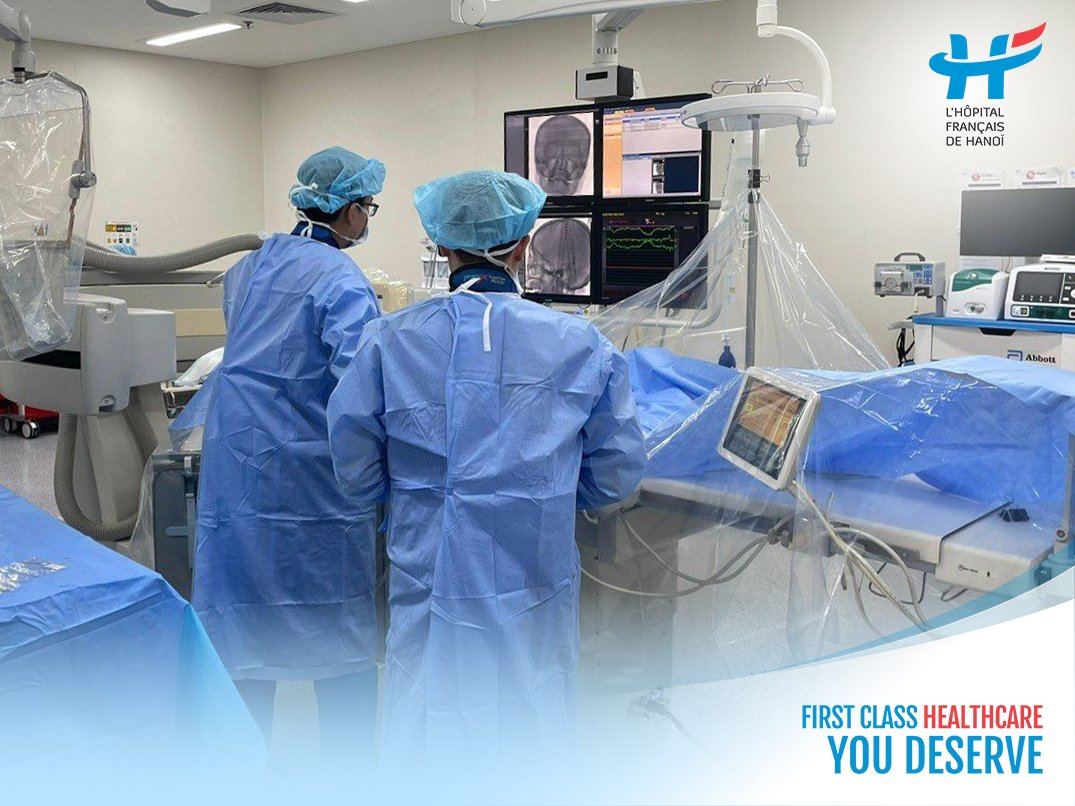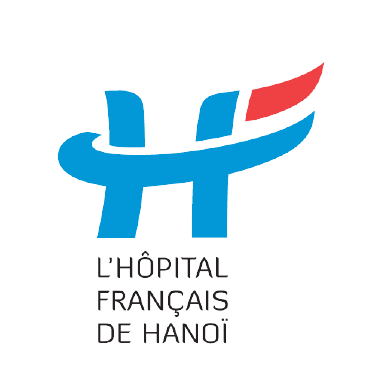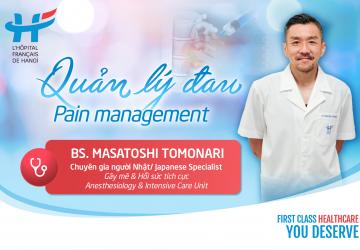News - Thu, 07/18/2024 - 13:55
Venous Stent Relieves Patient’s 14-Year Tinnitus Affliction
Last update 09/19/2024 - 16:47

Hanoi French Hospital has successfully conducted a complex intervention to save a female patient, 50, suffering from a rare condition known as cerebral vein stenosis.
Rare condition
Patient N.T.H. reported that after giving birth to her second child 14 years ago, her right ear constantly heard a whooshing sound, accompanied by dizziness, insomnia, and chronic headaches. Despite seeking medical help from various places, spending up to a billion VND, the cause of her condition remained undiagnosed. Enduring this strong tinnitus daily without a diagnosis, she eventually resorted to high-dose antidepressants. In recent years, the all the symtoms got worse, and she had to completely quit her job.
During her visit to Hanoi French Hospital, inner ear abnormalities and common neurological issues such as brain tumors, arterial malformation had been ruled out, by brain CT, MRI, and even conventional angiography.
After this first step, despite these negative results, the French internal medicine and neurology specialists at Hanoi French Hospital — Dr. Sabrina Stefanizzi Debuc and Dr. Christian Brosset decided to go further. They were conviced that the patient was not only suffering of a depression, and that the depression was the consequence of her undiagnosed disease.
Thanks to a thorough clinical examination, they noticed a rare abnormality, that could be caused by a cerebral venous stenosis, whose diagnosis on brain imaging is very difficult. Thus, they organized a collaboration with the most specialized team in France at Lariboisiere Universitary hospital in Paris.
After consulting with these vascular interventional radiologists experts, they could confirm that the patient had a severe right transverse sinus stenosis. This abnormality could explain all the patient's suffering over the past years. And it was a treatable disease.
Given that it is not a common procedure in Vietnam, the collaboration with Paris university hospital continued, to discuss about the technical issues, and assess if it was doable here. Thanks to the strong experience in interventional neuro radiology of Dr. Nguyễn Ngọc Cương, the decision has been taken that the best solution for the patient was to be treated our hospital.

Dr. Nguyễn Ngọc Cương, a specialist in cerebral vascular intervention, said: "Cerebral vein stenosis is a rare condition globally. Imagine a vein as a pipeline, similar to a water hose. When the hose is narrowed, the flow speeds up and jets further. Initially, the cerebral vein is as wide as usual, but over time, as the condition develops, the vein narrows, functioning like the water hose. When blood flows through the narrowed section of the vein, its speed increases rapidly.”
“The patient's vein narrowing is located right next to the ear, causing the blood flow to exert significant pressure as it passes through. This explains why the patient hears a whooshing sound in her ear. Additionally, this vein narrowing prevents blood from being efficiently transported back to the heart, causing it to pool in the brain, which increases intracranial pressure and leads to the chronic headaches the patient experienced. The situation worsened over time as she endured both the tinnitus and headaches for 14 years."
Venous Stenting – Complex and Rarely Performed Procedure
After a thorough discussion, the experts decided to place a stent in the patient's right transverse sinus to clear the obstruction and restore normal blood flow. While arterial stenting is a common procedure for many conditions, venous stenting, particularly within the brain, is extremely rare. Successfully diagnosing the condition was challenging, and the intervention itself was equally difficult.
According to Dr. Nguyễn Ngọc Cương, three main challenges were encountered in this case.
First of all, venous stenting in the brain is not a routine procedure. The technique was relatively new to the doctors specializing in cerebral vascular interventions. This required combining various tools from neurointervention and coronary intervention, as there are no specialized instruments solely for cerebral venous stenting.
Secondly, the brain vein in question had a diameter of only 2.3 mm, the same as the catheter used. Additionally, the brain’s blood vessels are not straight but rather twisted and complex. Successfully navigating the catheter through the narrow section was crucial for the intervention's success.
Thirdly, the brain’s venous sinuses have many cavities and corners. If the catheter was not carefully guided, it could easily get stuck in these recesses, preventing the stent from being deployed and the catheter from being advanced.
Anticipating the difficulties, the doctors at Hanoi French Hospital successfully performed the surgery on the patient in just over an hour, thanks to their mastery of the technique and modern equipment.
The intervention involved two main approaches. The first approach was the arterial route. They accessed the artery through the femoral artery, navigating up to the cerebral artery to precisely locate the stenosis. The second approach was the venous route. Simultaneously, they made an entry through the jugular vein in the neck, advancing the catheter up to the brain vein to place the stent.

Following the successful intervention and identification of the cause, the right ear tinnitus symptoms of patient completely disappeared immediately after the procedure. She can now live a normal life and had her first restful sleep in 14 years.

Saving Patients from Hidden Stroke Risks
Dr. Nguyễn Ngọc Cương emphasizes that untreated cerebral vein stenosis can increase pressure within the brain, posing a high risk of stroke.
This condition is rare worldwide and often overlooked. Patients typically present with tinnitus on the affected side, while ear, nose, and throat examinations or neurological evaluations may yield normal results.
A critical diagnostic method involves compressing the jugular vein on the affected side, which can temporarily alleviate tinnitus symptoms entirely. Diagnosing this condition requires experienced professionals due to the subtle imaging signs of internal cerebral vein stenosis.
Doctors advise that upon experiencing unusual symptoms such as tinnitus, headaches, or dizziness, after ruling out other causes related to the ear or nervous system, patients should promptly seek specialized evaluation from leading neurovascular specialists. This early intervention can detect and treat the condition quickly, preventing dangerous complications that could impact life expectancy.



